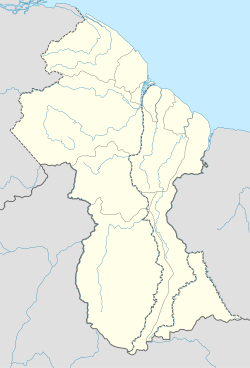Albion, Guyana
|
Albion No. 5 Village |
|
|---|---|
| town | |
| Location in Guyana | |
| Coordinates: 6°15′0″N 57°22′48″W / 6.25000°N 57.38000°WCoordinates: 6°15′0″N 57°22′48″W / 6.25000°N 57.38000°W | |
| Country |
|
| Region | East Berbice-Corentyne |
| Population (2002) | |
| • Total | 1,475 |
| Time zone | UTC-4 |
Albion is a town in the country of Guyana.
It is located approximately 18 kilometres (11 mi) east of the town of New Amsterdam, Guyana along the one and only main road. Part of Albion is known as Albion High Reef.
The small village has about three thousand inhabitants, 95% of which are Indians from India, whose ancestors came over on British ships from India beginning in 1838, in the capacity of indentured laborers, to work on the giant sugar plantations in British Guiana. The remaining 5% of the population in Albion is split between Blacks, Amerindians (native indigenous tribes from South America), and Chinese.
Albion is home to the largest sugar manufacturer in the Caribbean region. Electric and municipal water supplies, even though they were available in many areas since the 1970s, they were first made available in 1998 to areas that were once sqatting areas prior to 1998. The people live entirely off the land, growing eggplant, tomatoes, squash, melons, spinach, eddoe (or taro leaf), okra, and a wide number of tropical fruits like guava, mango, coconut, banana, and star apple. Fish are also readily available in the many trenches that lead out to the Atlantic Ocean, as well as shrimp, crab, snails, and also many wild birds.
Albion, like all of Guyana, is heavily infested with several types of mosquitoes, though diseases like dengue and yellow fever, as well as malaria, have almost completely been eradicated in the Albion coastal areas. Still, the mosquitoes and flies are quite a constant harassment, and people must sleep under mosquito nets.
The cuisine is quite interesting, as it has retained very much of its East Indian quality. Curries cooked with garam masala and other Indian spices are very common, and Hindu and Muslim holidays are celebrated in much the same way as in India to this day.
Indian movies are watched on a daily basis. Many, if not all of the movie theatres that were once part of life up until the 1990s are gone and replaced by home entertainment systems. The availability of TV sets in the 1990s revolutionized the way movies are now watched.
...
Wikipedia

